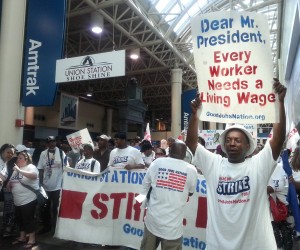
By: The New York Times Editorial Board
On Thursday, the day after the 50th anniversary of the March on Washington, thousands of fast-food workers in 60 cities walked off their jobs, the latest in an escalating series of walkouts by low-wage workers demanding higher pay and the right to organize without retaliation.
The parallels, though inexact, are compelling. A half-century ago, the marchers called on Congress to increase the minimum wage from $1.15 an hour to $2 “so that men may live in dignity,” in the words of Bayard Rustin, one of the chief organizers of the march. Today, the fast-food workers also seek a raise, from the $9 an hour that most of them make to $15.00 an hour. That’s not much different from what the marchers wanted in 1963; adjusted for inflation, $2 then is $13.39 an hour today.
The strikers are targeting their employers — profitable companies like McDonald’s, Yum Brands (which includes Taco Bell, Pizza Hut and KFC) and Wendy’s. But Congress could help. Today’s minimum wage is a miserly $7.25 an hour — which is actually lower, adjusted for inflation, than it was 50 long years ago. Raising it would support the legitimate demands of the strikers and underscore the pressing needs of the country’s growing ranks of low-wage workers.
President Obama has noted, correctly, that increases in labor productivity have long failed to translate into higher wages for most Americans, even while income for the richest households has skyrocketed. His proposed remedies, however, leave much to be desired — a pathetic increase in the minimum wage, to $9 an hour by 2016, plus hopeful assertions that revolutions in energy, technology, manufacturing and health care will create good-paying jobs.
On its own, however, growth will not raise wages. What’s missing are policies to ensure that a large and growing share of rising labor productivity flows to workers in the form of wages and salaries, rather than to executives and shareholders. Start with an adequate minimum wage. Provide increased protections for workers to unionize, in order to strengthen their bargaining power. Provide protections for undocumented workers that would limit exploitation. Add to the mix regulations to prevent financial bubbles, thereby protecting jobs and wages from ruinous busts. Adopt expansionary fiscal and monetary policies in troubled times to sustain jobs and wages.
Low-wage workers would also benefit from executive-branch orders to ensure fair pay for employees of federal contractors. All workers need stronger enforcement of labor law so they are not routinely misclassified in ways that deny wages, overtime and benefits. They also need a tax system that is more progressive to shield wage earners from unduly burdensome tax increases or government cutbacks.
They need, in brief, pro-labor policies that have been overlooked for decades, with devastating results: from 1979 to 2012, typical workers saw wage increases of just 5 percent, despite productivity growth of nearly 75 percent, while wage gains for low-wage workers were flat or declined.
Recent experience has been even worse. In the decade from 2002 to 2012, wages have stagnated or declined for the entire bottom 70 percent of the wage ladder. The marchers had it right 50 years ago. The fast-food strikers have it right today. Washington has it wrong.
Original Article: http://www.nytimes.com/2013/09/01/opinion/sunday/labor-then-and-now.html
